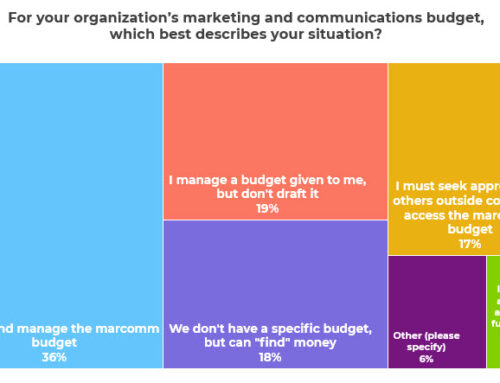
As a nonprofit marketer, getting your budget items or overall budget approved is a crucial part of rolling out an effective marketing strategic plan but can sometimes be intimidating. Here are 4 ways to get you there!
For more on nonprofit marketing budgets, join us for Strategic Nonprofit Marketing Budgets: Your Roadmap to Approval and Impact. You can pay $99 to register for just this webinar or attend ALL of our 2024 webinars and workshops for only $599 with an All-Access Pass (normally $799; sale ends 1/5/24). To learn more about what we are offering in 2024, see Reveal Video: Our 2024 Nonprofit Communications Training Schedule.
1. Align with Strategic Goals
Understanding and aligning your budget request with the organization’s strategic plan and business goals is numero uno. Successful leaders are focused on propelling their organizations forward with sustainable revenue and impact. Whatever aspect of marketing your request pertains to, it must demonstrate a clear return on investment (ROI) in relation to one of these two objectives. You must be able to articulate how those marketing activities will contribute to generating more revenue or increasing impact. The idea is to leave no doubt that we are all on the same page with achieving mission outcomes.
Gone are the days when marketing activities could solely be justified for “awareness” purposes; now, it’s all about tangible outcomes.
2. Build Strong Relationships
First things first is always people. Make sure you have a solid connection with your finance team or accounting person. You should be meeting with them regularly, or at least more than once a year, to grasp the organization’s current financial status. Understanding your team’s financial situation, even if it’s a one-person team, is equally important. If meeting with finance isn’t an option, maintain open communication with your supervisor to stay informed about the financial landscape. This context is essential when you’re considering your budget request.
Additionally, it’s beneficial to find a champion within senior leadership or someone with influence who understands your goals. Having an advocate makes everything easier. Try to locate someone who can help lay the groundwork for your request in advance.
Remember that your final budget should align with a clear and strategic marketing plan that fits within the organization’s financial capacity at that time. Being aware of the current financial outlook is crucial.
3. Benchmark and Measure with KPIs
Incorporate benchmarking practices to compare your marketing efforts and costs with industry standards and best practices. This can be a little tricky the more niche you try to get with your organization’s cause but do the best you can.
Simultaneously, establish key performance indicators (KPIs) to measure the success of your initiatives. Utilize these metrics to demonstrate the effectiveness of your marketing campaigns in achieving organizational goals. Data-driven insights show that you are serious about using the funds effectively and are compelling when seeking budget approval.
4. Responsible Fund Management
Show responsible management of previous funds or projects, especially if you’ve been working with limited resources. Highlight what you’ve achieved with these constraints and illustrate how additional financial support could lead to even greater accomplishments.
If you’ve had a budget in the past, be prepared to discuss the ROI it generated. That history of success can pave the way for future fund allocation.
Bonus Tip: Avoid Excessive Underspending!
While we all know that it’s essential to be mindful of budget spend, you want to steer clear of excessive underspending or being overly frugal. Request an amount that you genuinely believe is necessary for effectiveness and then use it.
What you should be doing is monitoring the use of funds as you go, ensuring they are being used effectively and efficiently. This proactive approach allows you to adjust your budget as needed.
Remember that striking the right balance of funds is key to reaching your target audience effectively, enhancing visibility, and boosting engagement. Massive underspending is a no-no if you want to avoid the risk of being seen as so frugal in the past that future funding may be denied.
—
Incorporate these strategies into your budget request process and you will be sure to get at least a little closer to yes. Remember, it’s not just about asking for funds; it’s about making a compelling case for investing in your mission-driven marketing efforts.






